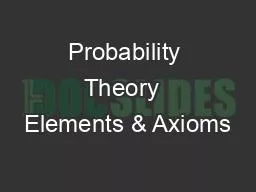

Probability Space of Two Die σ Algebra ℱ Sample Space Ω E514233241 Probability Measure Function P P E5 011 Probability Measure Function P ID: 801266
Download The PPT/PDF document "Probability Theory Elements & Axiom..." is the property of its rightful owner. Permission is granted to download and print the materials on this web site for personal, non-commercial use only, and to display it on your personal computer provided you do not modify the materials and that you retain all copyright notices contained in the materials. By downloading content from our website, you accept the terms of this agreement.
Slide1
Probability Theory
Slide2Elements & Axioms
Slide3Probability Space of Two Die
σ-
Algebra (
ℱ
)
Sample Space (Ω)
[...]
E5={(1,4),(2,3),(3,2),(4,1)}
[...]
Probability Measure Function (P)
P
E5
0.11
Slide4Probability Measure Function (P)
Probability Theory
σ-
Algebra (
ℱ
)
Sample Space (Ω)
E5={(1,4),(2,3),(3,2),(4,1)} [...]
P
E5
0.11
(1,1) (1,2) [...]
Probability Space (Ω, ℱ, P)
3. σ-Additivity
2. Unit Measure (i.e., unitarity)
1. Non-negativity
Probability Axioms
E.g.: P(3dots or 4dots) = P(3dots) + P(4dots) = ⅙ + ⅙ = ⅓
Slide5Exercise 4.3) Probability Example
In a pinochle deck, there are 48 cards:
6 values (9, 10, Jack, Queen, King, Ace) x 4 suits x 2 copies = 48
What is the probability of drawing a 10?
What is the probability of drawing { 10 or Jack }?
Recall: σ-Additivity
Slide6Probability Space vs Other Spaces
Prob space
(Unit Measure)
3. σ-Additivity
2. Unitarity
1. Non-negativity
3. Probability Function (P)
2.
σ-
Algebra (ℱ)
1. Sample Space (
Ω
)
Elements
Axioms
If you remove the unitarity axiom, probability space is a measure space.
If you remove the measure function, you are left with a topological space.
In fact, probability space is just a specific resident of the “space of mathematical spaces”.
Why don’t we use e.g., Banach spaces instead?
Slide7Plausibility Inference or Frequency Analysis?
Requirements For A
Plausibility Inference
System
Probability Theory
Requirements For A
Frequency Analysis
System
Bayesian
Perspective
FrequentistPerspective
Cox’s Theorem
Bayes
Kolmogorov Axioms/Theorems
Plausibility Axioms
Slide8Frequentism vs Bayesianism
Slide9Externalism: Probability as Frequency
Slide10Internalism: Probability as Degree of Belief
As we saw, calibration can improve credibility estimates in the long term.
Simulated betting is a way to elicit (materialize) your subjective credibilities.
Proposition X ≝ “A snowstorm will close highway near Indianapolis on Christmas”
Decision 1
Gamble A
: You get $100 if X is true
Gamble B: You get $100 if you draw red from a bag with { 5 red, 5 white } marbles.Suppose you prefer Gamble B. This means your subjective P(X) < 0.5.
Decision 2
Gamble A: You get $100 if X is trueGamble B: You get $100 if you draw red from a bag with { 1 red, 9 white } marbles.
Suppose you pick Gamble A. This means your subjective P(X) > 0.1.
Slide11Probability Distributions
Slide12Recall: Two Kinds of Distribution
1/6
DiceRoll
Snowfall (inches)
Probability Density Function (PDF)
Probability Mass Function (PMF)
1
2
3
4
5
6
DiceRoll has discrete domain
:
{ 1, 2, 3, 4, 5, 6 }.
Unitarity means: ∑X
e
= 1
It is also true that: ∀
X
e
, Prob(
X
e
) < 1
Snowfall has continuous domain [0, ∞)
Unitarity means: ∫ p(x) dx = 1
It is
not
true that:
∀dx, p(x) < 1
PMF
PDF
Slide13Continuous Bins
Bin Size = 2in
Bin Size = 1in
Slide14Example of p(x) > 1.0
A milligram of metal lead has a density of
~ 11 grams/cm
3
This is possible because a milligram of lead takes up 0.000088 cm3 of space.
As bin size becomes infinitesimally narrow, Prob(X) approaches zero. But the ratio of probability mass to interval width is meaningful to talk about.
Let p(x) ≝ Prob(X) / dxIn the same way, if probability mass is compressed into a very small area, p(x) can exceed 1.0, without violating unitarity.
Slide15Unitarity: Discrete vs Continuous
We can
algebraically manipulate the discrete unitarity formula, and arrive at the continuous unitarity formula.
Multiplying Δx /
Δx doesn’t change the formulae.
As
Δx → 0, we rename each term.
Note: p(x) ≠ Prob(x)
∑ Prob([xi, xi + Δ
x]) = 1
∑ Δx * Prob([xi, xi + Δx]) /
Δx
= 1
∫
dx
p(
x)
This is how we move PMF → PDF
∑Prob(X
e
) = 1 → ∫ dx p(x) = 1
Slide16Density for normal distributions
Slide17Variance is,
Descriptive Statistics
Central Tendency
: mean, median, mode, etc.
Question: what is the relation between μ and E[x]?
Uncertainty
: stdev, etc
Expectation Operator is,
Suppose I asked you to compute min(var
x
). What is the solution?
E[x]. In this sense, mean pairs with stdev.
If we were trying to minimize (x - M), the median would minimize the expected distance.
Slide18Exercise 4.4
Let’s run through an example probability density, and calculate E[x]
Example
Let p(x) = 6x*(1-x) for x ∈ [0,1]
Recall,
Let’s check our work...
Slide19High Density Interval
Another way to summarize a distribution, will be to use High Density Intervals (HDIs). We will use HDIs most often.
Unitarity: For all x,
∫ dx p(x) = 1.00
HDI: Range(s) of x, ∫ dx p(x) = 0.95
Example Distributions:
1. Normal
2. Skewed
3. Bimodal
Slide20Two-Way Distributions
Slide21Joint & Marginal Probabilities
Consider two discrete random variables: hair and eye color.
Each cell in this table (e.g., Prob(Black Hair, Green Eyes)) is a
joint probability
.
If we collapse a dimension (e.g., row totals), we have
marginal probabilities.
We can distribute probabilities across multiple variables simultaneously.
Slide22Conditional Probabilities
To condition on blue eyes, you simply filter out other outcomes.
Filtering violates unitarity.
After you condition on other outcomes, renormalize
Prob(h|blue) is pronounced “hair color
given
blue eyes”
Slide23Conditional Probabilities: Formal Definition
Conditionals use normalization.
Each cell here is:
p(h|blue) = p(blue, h) / p(blue)
This normalization process generalizes. Conditional probabilities can be defined as:
Next week, we will use this definition to derive Bayes Theorem.
Slide24Exercise 4.1) Conditional Probabilities in R
Let’s run through this scenario in R.